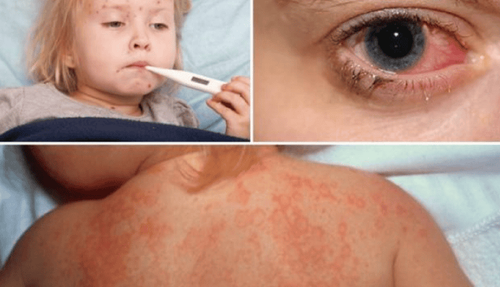The article is professionally consulted by Master of Medicine, Dr. Nguyễn Thị Nhật - Infectious Disease Specialist - Department of Internal Medicine - Vinmec Hai Phong International General Hospital.
Dengue fever and viral fever are currently in peak season. So, when you have a fever, how can you distinguish between a common fever, viral fever, or dengue fever? How should dengue fever be treated?
1. Common fever
Common fever is a temporary increase in body temperature in response to illness. Body temperature is not constant and fluctuates at different times of the day, usually higher in the afternoon. However, if the body temperature exceeds 37.5 degrees Celsius, it is considered a fever.
A common fever occurs when the body reacts to infectious agents such as flu or cold viruses, bacteria causing sore throat, or inflammation due to tissue damage or certain diseases. Additionally, external factors from the environment, such as sunstroke, cold, medication, or chemicals, can also cause fever.
2. Viral fever
Viral fever can be caused by many different viruses and is also characterized by an increase in body temperature. Viral fever is quite diverse because there are thousands of different viruses, such as the dengue virus, which causes dengue fever and is transmitted through the bite of an Aedes mosquito. After being bitten by a mosquito that transmits the virus, the patient will show symptoms of dengue fever after about 4-7 days. Viral fever in children is often more severe and more common than in adults because children's immune systems and resistance are not yet fully developed.
2.1. Signs of viral fever in children
Viral fever in children often manifests as sudden high fevers of 39-40 degrees Celsius, accompanied by other symptoms such as:
- Muscle pain: When having a viral fever, some children show signs of body aches, with pain concentrated in the muscles.
- Headache, irritability, lethargy: Common in young children, showing unexplained irritability, although some cases may still be alert and playful despite having a headache.
- Skin rash: Usually appears 2-3 days after the fever starts (the child feels better when the rash appears).
- Other symptoms: Such as watery eyes, red eyes, eye pain, a lot of eye discharge, causing blurred vision.
- Difficulty breathing, seizures: Some young children with severe viral fever may have continuous seizures, accompanied by difficulty breathing and rapid breathing.

2.2. Signs of viral fever in adults
- Fatigue, lethargy: This is one of the most characteristic signs of viral fever in adults.
- Body aches: Similar to children, due to fatigue and increased body temperature, patients with viral fever often experience body aches, especially in the muscles.
- Fever: High body temperature is one of the typical symptoms of viral fever in adults. The high body temperature indicates a worsening infection, with the fever sometimes reaching up to 40 degrees Celsius.
- Cough, runny nose: Viral fever causes chills, leading to coughing and a runny nose.
- Nasal congestion: After coughing and a runny nose, there is nasal congestion, difficulty breathing, and wheezing.
- Headache: Patients with viral fever often experience headaches, especially after the fever.
- Skin rash: In some cases, patients develop a rash on the skin, accompanied by fever.
3. Dengue fever

Dengue fever in children often presents more severely than in adults. This is because children with dengue fever are more prone to shock and recurrent shock, which can be very dangerous if not treated promptly.
Dengue fever typically progresses through three stages, each with different symptoms. The initial stage of dengue fever can be mistaken for common fever or viral fever. However, the clinical presentation of dengue fever is mainly characterized by symptoms such as skin congestion, petechial rash (bleeding signs), and gum bleeding. If the condition worsens, patients may experience symptoms like abdominal pain in the liver area, enlarged liver, reduced urine output, frequent vomiting, and blood tests showing increased hematocrit levels and rapidly decreasing platelet counts.
In children, dengue fever manifests as a sudden high fever, headache, fatigue, loss of appetite, body aches, pain around the eyes, mucosal congestion, petechial rash, and possibly gum bleeding. More seriously, children may suffer from internal bleeding, respiratory failure, and circulatory failure if not detected and treated in time.
Thus, in the early high fever stage of dengue fever (the first three days), it can only be distinguished from other viral fevers through test results (if diagnosed early). In later stages, it can be differentiated through both tests and clinical symptoms.
It is important to note that with common viral fevers, symptoms usually subside once the fever breaks. In contrast, with dengue fever, the period after the fever subsides is when the disease enters a dangerous complication phase, requiring close monitoring and timely intervention to manage any complications that arise.
4. How to Handle Dengue Fever?
When a patient notices fever accompanied by the following symptoms, they should go to a medical facility for accurate diagnosis and active treatment by a doctor:
- Persistent high fever for 3-4 days without improvement.
- Extreme fatigue.
- Frequent vomiting.
- Restlessness or lethargy.
- Severe abdominal pain, especially in the liver area.
- Reduced urine output.
- Unusual bleeding: Nosebleeds, gum bleeding, petechial rash under the skin, abnormal menstruation, vomiting blood, black stools, or blood in stools.
Dengue fever cannot be directly transmitted from person to person but is spread through the bite of an Aedes mosquito. Therefore, to prevent dengue fever, people must actively prevent and eliminate mosquitoes and larvae, sleep under mosquito nets to avoid mosquito bites, clean up around the house to prevent mosquito breeding, improve physical health, and maintain personal hygiene.
MSc. Dr. Nguyễn Thị Nhật has over 10 years of experience in the field of artificial kidney and infectious diseases, examining and managing patients with kidney diseases and infectious diseases. She is currently an Infectious Disease Specialist at the General Internal Medicine Department of Vinmec Hai Phong International General Hospital
Please dial HOTLINE for more information or register for an appointment HERE. Download MyVinmec app to make appointments faster and to manage your bookings easily.














